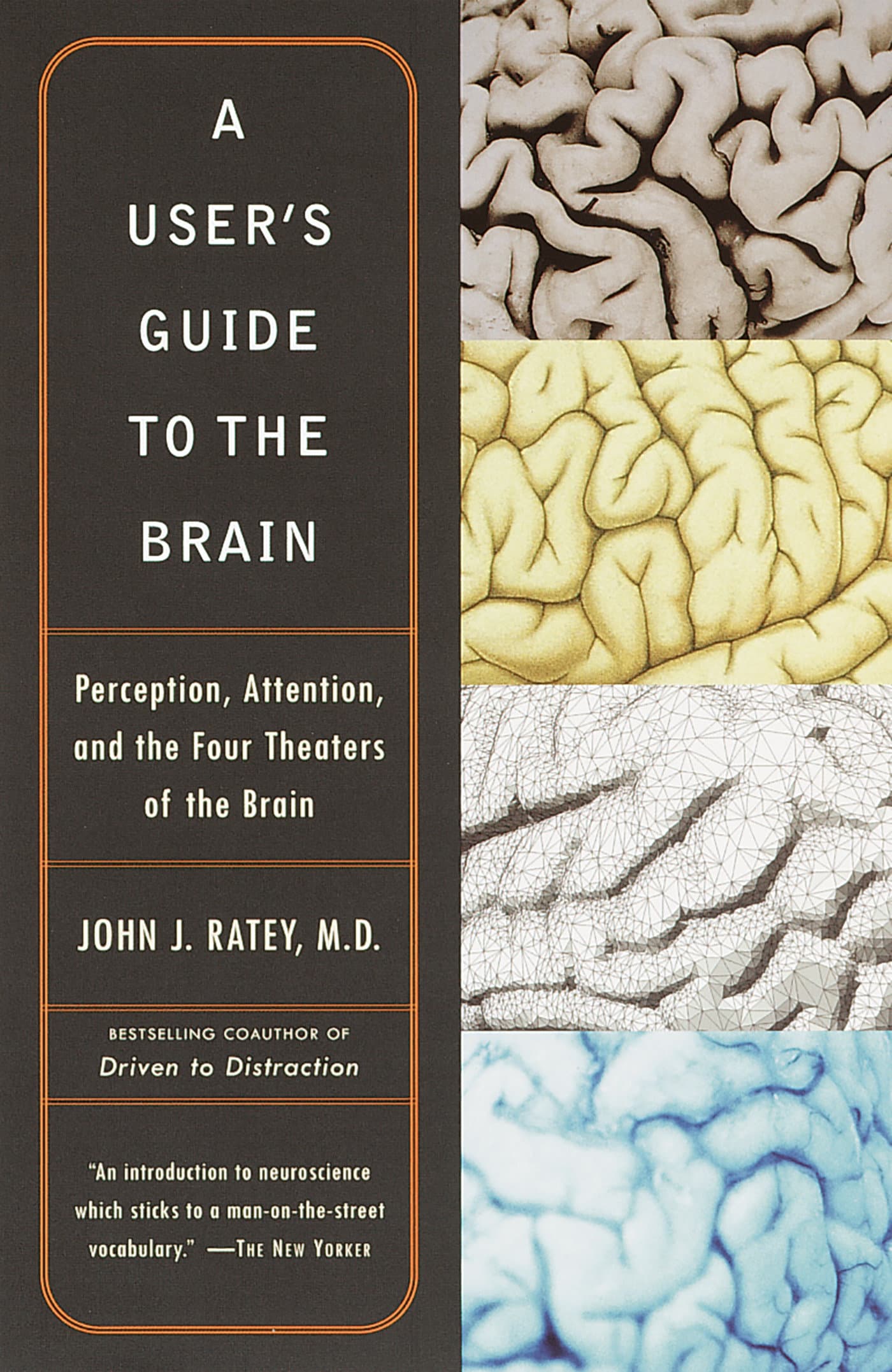A User’s Guide to the Brain: Perception, Attention, and the Four Theaters of the Brain
18.00 JOD
Please allow 2 – 5 weeks for delivery of this item
Add to Gift RegistryDescription
John Ratey, bestselling author and clinical professor of psychiatry at Harvard Medical School, lucidly explains the human brain’s workings, and paves the way for a better understanding of how the brain affects who we are. Ratey provides insight into the basic structure and chemistry of the brain, and demonstrates how its systems shape our perceptions, emotions, and behavior. By giving us a greater understanding of how the brain responds to the guidance of its user, he provides us with knowledge that can enable us to improve our lives. In A User’s Guide to the Brain, Ratey clearly and succinctly surveys what scientists now know about the brain and how we use it. He looks at the brain as a malleable organ capable of improvement and change, like any muscle, and examines the way specific motor functions might be applied to overcome neural disorders ranging from everyday shyness to autism. Drawing on examples from his practice and from everyday life, Ratey illustrates that the most important lesson we can learn about our brains is how to use them to their maximum potential.
Additional information
| Weight | 0.4 kg |
|---|---|
| Dimensions | 2.3 × 13.5 × 20.4 cm |
| PubliCanadation City/Country | USA |
| Author(s) | |
| Format Old` | |
| Language | |
| Pages | 416 |
| Publisher | |
| Year Published | 2002-1-8 |
| Imprint | |
| ISBN 10 | 0375701079 |
| About The Author | Best selling author, John J. Ratey, MD, is an Associate Clinical Professor of Psychiatry at Harvard Medical School and an internationally recognized expert in Neuropsychiatry. He has published over 60 peer-reviewed articles, and 11 books published in 15 languages, including the groundbreaking ADD-ADHD Driven to Distraction series with Ned Hallowell, MD. |
“[A]n introduction to neuroscience which sticks to a man-on-the-street vocabulary.” –The New Yorker“Will explain that mysterious space between your ears . . . in an accessible way.” –Psychology Today“Excellent. . . . Ratey takes the reader on a wondrous journey.” –The Providence Sunday Journal |
|
| Excerpt From Book | 1DEVELOPMENTShe was doing it again. That young woman who periodically showed up dressed in a Western shirt and kerchief was standing in front of the automatic sliding doors at the Safeway supermarket. She'd look intently straight ahead, take five abrupt steps toward the doors, and try to restrain herself from walking through until they had fully opened. Sometimes she couldn't stop herself and nearly slammed right into the glass. Other times she'd wait long enough and then lunge through. Regardless, she'd back out and do it again. And again. Regular shoppers at the Phoenix, Arizona, store would hesitate beside her, then scurry past, eyeing her while trying not to stare. Once inside they'd shake their heads and make the usual comments: "Must be insane." They didn't know that Temple Grandin would go on to earn a doctorate in animal sciences and become an internationally recognized expert in animal handling. Or that she was autistic.Temple had a normal birth, but by the time she was six months old she'd stiffen at her mother's touch and claw to free herself from her mother's hug. Soon she could not stand the feeling of other skin touching hers. A ringing telephone and a car driving by her house while a conversation was going on inside caused such severe confusion and hurt in the toddler's ears that she would tantrum, hitting whoever was within reach.When she was three the doctors said that Temple had "brain damage." Her parents hired a stern governess, who structured the child's day around physical exercise and repetitive play such as "marching band." Occasionally the routine allowed Temple to focus on what she was doing, even speak. She taught herself to escape the stimuli around her, which caused pain in her overly sensitive nervous system, by daydreaming in pictures of places far away. By the time she reached high school she had made great progress. She could handle some of the academic subjects, and sometimes she could control her hypersensitive reactions to the chaos around her, primarily by shutting down to reduce the constant anxiety and fear. This made the other kids regard her as cold and aloof. She grew agonizingly lonely and would often tantrum or engage in pranks to combat her feelings of rejection. The school expelled her.When she was sixteen Temple's parents sent her to an aunt's cattle ranch in Arizona. The rigid daily schedule of physical work helped her focus. She became fixated on the cattle chute, a large machine with two big metal plates that would squeeze a cow's sides. The high pressure apparently relaxed the animals, calming them enough for a vet to examine them. She visualized a squeeze machine for herself to give her the tactile stimulation she craved but couldn't get from human contact because the stimulation from physical closeness to another person was too intense, like a tidal wave engulfing her.By this time Temple and her doctors had realized that she had a photographic memory. She was an autistic savant. When she returned to a special school for gifted children with emotional difficulties–the only school option left–her advisors allowed her to build a human squeeze machine. The project got her hooked on learning mechanical engineering and mathematics and on problem-solving, and she excelled at them all. She built a prototype, and would climb into it and use a lever to control the degree and duration of the pressure on her body. Afterward, she would feel relieved, more empathic, and more in touch with feelings of love and caring, even more tolerant of human touch. She started controlled experiments with the device and became skilled in research and lab techniques–which provided the impetus to apply to college.Temple's state of hyperarousal and her inability to manage environmental stimuli impaired her ability to cope with the normal surroundings of her family or peers. The repetitive exercises as a child, the squeeze machine, and her academic successes gradually gave her the ability to control her offending behavior. Yet by her late twenties she still had had no success in creating social relationships. She was in a constant state of stage fright. She would get so anxious about approaching someone that she would literally race up and knock the person over, unable to restrain her muscles as she got emotionally energized. If she did manage to stop in time she would stand collar to collar, talking three inches from the person's face, an instant turnoff.Then Temple put it all together. Walking up to someone in a socially acceptable way was the same as approaching the automatic doors at the supermarket. Both had to be done at the same relaxed pace. So she started showing up at the Safeway. She practiced approaching the doors for hours on end, until the process became automatic. The exercise helped. She found that she could approach people properly if she visualized herself approaching the doors. The doors were like a physical map; they provided a concrete visual picture of an abstract idea about approaching social interactions carefully.Temple used another rehearsal technique to learn how to negotiate with people, a stressful interaction that usually sent her reeling. She read the New York Times's accounts of the Camp David peace talks conducted by President Jimmy Carter with Egypt's Anwar Sadat and Israel's Menachem Begin. She read every word and memorized them at once; being a savant came in handy. She played the conversations over and over again in her brain, like watching an internal videotape, and used them to guide her own conduct when negotiating with real people.Today Temple Grandin, at fifty-one, leads a fulfilling professional and social life. It is twenty-five years since her training in front of the Safeway doors, and she has learned to pay attention to certain stimuli while ignoring others so that she does not become overly aroused. She also takes low doses of an antidepressant drug that alleviates her pent-up discomfort even better than the squeeze machine.Temple resorted to a host of unusual practices to rewire her faulty brain circuits in order to control her conduct. She developed the circuits that enabled her to approach the supermarket doors, and then used these newly trained circuits to help position herself with relation to other people. She mastered each technique with practice, made it automatic, and then applied the newly imprinted pattern to other cognitive skills. Temple developed in adulthood the brain circuits her physical childhood development did not provide.The brain is not a computer that simply executes genetically predetermined programs. Nor is it a passive gray cabbage, victim to the environmental influences that bear upon it. Genes and environment interact to continually change the brain, from the time we are conceived until the moment we die. And we, the owners–to the extent that our genes allow it–can actively shape the way our brains develop throughout the course of our lives. There is a great ongoing debate between different schools of neuroscientists as to whether the brain is merely a "ready-to-respond-to-environment" machine, an idea championed by a group who identify themselves as "connectionists," and those who would say that the brain is genetically made up of "ready-to-access" modules that the environment merely stimulates. However, the majority of neuroscientists see a hybrid, where the broad outlines of the brain's development are under genetic control, while the fine-tuning is up to the interaction of brain and environment.Certainly, much of the course of our brains' development is determined while we are fetuses and young children. But as we will see, there are many other factors that can alter the process–in pregnancy, childhood, adulthood, and old age. A father's smile, exercise before the workday, a game of chess in the retirement home–everything affects development, and development is a lifelong process.We are not prisoners of our genes or our environment. Poverty, alienation, drugs, hormonal imbalances, and depression don't dictate failure. Wealth, acceptance, vegetables, and exercise don't guarantee success. Our own free will may be the strongest force directing the development of our brains, and therefore our lives. As Temple's experience shows, the adult brain is both plastic and resilient, and always eager to learn. Experiences, thoughts, actions, and emotions actually change the structure of our brains. By viewing the brain as a muscle that can be weakened or strengthened, we can exercise our ability to determine who we become. Indeed, once we understand how the brain develops, we can train our brains for health, vibrancy, and longevity. Barring a physical illness, there's no reason that we can't stay actively engaged into our nineties.Research on the brain's development has been fast and furious in this decade. The subject has become so popular that in the last few years it has rated a cover story in Time (three times), Newsweek (twice), and Life, as well as in other major magazines. New imaging technologies and scores of studies are providing enormous insight into ways to help the brain develop in babies, children, and adults, even in fetuses in the womb. Of course, there is also the chance here for misdirection.The research has even prompted political action at the highest levels of government. In April 1997, Hillary Clinton hosted an all-day White House scientific conference, an unusual event, on new findings indicating that a child's acquiring language, thinking, and emotional skills is an active process that may be largely finished before age three. This premise is in stark contrast to the common wisdom of only a few years ago: that infants are largely passive beings who are somewhat unaware of their surroundings or who simply record everything in the environment without editing it. If infants are in fact editing and processing environmental stimuli, it behooves us to make these stimuli such good ones that they can move through them quickly and on to other learning.The problem here is that such notoriety can cause sweeping action that may run ahead of sound clinical trials and testing of new hypotheses. Based on research that is not fully confirmed, panelists at the White House conference urged the adoption of federal programs to increase wages and training for day-care workers, improve parenting education, broaden training of pediatricians, and expand prenatal health-care coverage.The best example of running ahead of research involves the "proof" that exposing infants to classical music enhances their brain development. Several recent studies indicate that this is so, yet others do not, and replication of the positive studies is not yet conclusive. Nonetheless, Georgia governor Zell Miller added $105,000 to his 1998 state budget proposal so that a cassette or compact disk of classical music could be included with the bag of free goodies that hospitals send home with each of the 100,000 babies born in the state each year. Miller's proposal, and his press conference about it, made national headlines. "No one questions that listening to music at a very early age affects the spatial, temporal reasoning that underlies math and engineering, and even chess," he said. "Having that infant listen to soothing music helps those trillions of brain connections to develop."While the governor's awareness of brain research was commendable, his action might have been premature. The worry is not that it may waste the state's money. As Sandra Trehaub, a professor of psychology at the University of Toronto who studies infants' perception of music, said in response, "If we really think you can swallow a pill, buy a record or book, or have any one experience that will be the thing that gets you into Harvard or Princeton, then that's an illusion." John Breuer, president of the McDonnell Foundation, a funding organization for biomedical and behavioral research as it affects education, warns that though there may be great advantages to early education programs, neuroscience does not provide reasons for it yet. The link is just beginning to become clear. And as Michael Gazzaniga, a noted neuroscientist at Dartmouth, cautions, we are in danger of being overdone with "politically correct pseudoscience babble" when we allow our enthusiasm to outstrip facts.Hillary Clinton realized herself that the White House conference could lead to premature and irresponsible decision-making and that the enthusiasm it catalyzed had to be tempered. Appearing on ABC's Good Morning America a week later, she admitted that the hyperfocus on properly stimulating babies "does ratchet up the guilt" about what parents ought and ought not to do.That is why we will take a careful look at research findings throughout this book, and particularly in this chapter. There is much we can learn about how to improve the development of our brains and those of our children. But we have to keep a trained eye out to distinguish research that can be applied to our daily lives from that which is, for now, simply interesting.A JUNGLE OF NEURONSThe human brain is responsible for the painting of Van Gogh, the creation of democracy, the design of the atomic bomb, psychosis, and the memory of one's first vacation and of the way that hot dog tasted. How does this organ encompass such diversity?The brain is not a neatly organized system. It is often compared to an overgrown jungle of 100 billion nerve cells, or neurons, which begin as round cell bodies that grow processes called axons and dendrites. Each nerve cell has one axon and as many as 100,000 dendrites. Dendrites are the main way by which neurons get information (learn); and axons are the main way by which neurons pass on information to (teach) other neurons. The neuron and its thousands of neighbors send out roots and branches–the axons and dendrites–in all directions, which intertwine to form an interconnected tangle with 100 trillion constantly changing connections. There are more possible ways to connect the brain's neurons than there are atoms in the universe. The connections guide our bodies and behaviors, even as every thought and action we take physically modifies their patterns.This description of the developing brain was heresy until recently. For decades scientists maintained that once its physical connections were completed during childhood, the brain was hard-wired. The tiny neurons and their interconnections were fixed; any neuron or link could die, but none could grow stronger, reorganize, or regenerate. Today, these axioms have been amended and enhanced. Thanks to sharp imaging technology and brilliant clinical research, we now have proof that development is a continuous, unending process. Axons and dendrites, and their connections, can be modified up to a point, strengthened, and perhaps even regrown.Temple Grandin's achievement demonstrates that the brain has great plasticity. But what was actually going on, physically, inside her head? We get a strong clue from Michael Merzenich at the University of California, San Francisco.Merzenich implanted electrodes in the brains of six adult squirrel monkeys, in the region that coordinates the movement of their fingers. Using computer imaging, he created a map of the neurons that fired when the monkeys manipulated objects with their hands. He then placed four food cups of decreasing diameter outside each of their cages. He put a single banana-flavored food pellet in the widest cup. The monkeys would reach through the bars and work their fingers into the cups until each was able to grasp its pellet and eat it. They practiced dozens of times for several days.Once they had mastered the widest cup, Merzenich put the food pellets in the next smaller cup. After several days of repetition, the pellets were moved to the third cup, then the fourth. By the end of the experiment the monkeys were extremely skilled with their fingers.After only one day, the computer images showed that the area of the brain that became active when the monkeys moved their fingers had increased in size. As the animals conquered successively smaller cups, the area got bigger; the number of cells that participated in the task increased. But after the neurons in the cortex mastered the fourth cup, the area shrank again; as the skill became more automatic, it was delegated to other parts of the brain lower down in the chain of command. The expanded portion of the executive part of the brain, the cerebral cortex, was no longer needed to carry out the skill and guide the hand. This commanding part of the brain, the control center, reverted back to its original size, freeing up neurons to learn other things.There is evidence that the same thing happens in humans as in Merzenich's monkeys. Alvaro Pascual-Leone of Harvard Medical School, Boston, and Avi Karni of Hadassah University Hospital, Israel, have independently shown, using mapping techniques–for example, magnetic resonance imaging (MRI) and transcranial magnetic stimulation–in living human subjects, that skill acquisition recruits more cortical neurons to master the skill, and that as the skill becomes more automatic, less of the recruited cortex is used.Thus, the brain has a tremendous ability to compensate and rewire with practice. Temple trained at the Safeway doors for hours each day for several months until the skill became automatic. At first it was incredibly difficult; by the end she did it with little concentration. Once she had mastered the initially higher-order activity, it was probably pushed down into lower regions of the brain, freeing her cortex to learn a new skill. The same would seem to be true about her rehearsing the Sadat-Begin tapes and applying them to her own conversations. Practice counts.What we learn from Temple's story and Merzenich's monkeys is that our brains are wonderfully plastic throughout adulthood. Brain structure is not predetermined and fixed. We can alter the ongoing development of our brains and thus our capabilities. This is not always beneficial, however, as sometimes in the brain's attempt to adapt, the rewiring can make things worse.MASSIVE CELL DEATHThe human brain has evolved, thanks to natural selection, always in the direction of pushing our genes forward. Different sections of the brain expanded and specialized from the less complex swelling at the end of a nerve cord in primitive vertebrates in order to adapt to different environments across evolutionary history. In fish and amphibians, the visual perception of motion was important to track prey or escape predators, so the parts of the brain responsible for this sense expanded over time in these animals. In monkeys and early humans, color perception was needed in order to tell which fruits were ripe and which were not, and perception of form was needed even in the absence of movement. Thus, a large expansion of cortex evolved to handle these complex visual challenges. Similarly, the need to manipulate these objects in trees and to get from one branch to another led to specialized motor systems not useful in the aquatic environment.Despite specializations typical only of our species, our brains retain the three basic components found in the simplest vertebrates: the hindbrain at the top of our spinal cord, which controls sensation and movement of the muscles of our face and throat; the midbrain, farther into the center of the head, which deals with some movements of the eyes and some rudimentary hearing and vision; and the forebrain, which achieves its most glorious development in human beings and which contains the cerebral cortex, the white-matter fibers connecting neurons of the cortex with each other and with other neurons, as well as those areas deep in the center of the brain that coordinate automatic sensory and motor functions. The cortex is the layers of neurons lying immediately below the bones of the skull, arching from just behind the forehead and over the top and sides, back to where the back of the head meets the neck. The cortex has evolved and expanded, adding many new functional areas, which participate in activities from playing basketball to designing software. Yet we retain our ancestral past; the seasonal depression many people experience in the dreary darkness of January may stem from animals that survived cold, foodless winters by slowing down their metabolism and hibernating. This ancient pathway remains in our brains despite electric heat and convenience stores.The human brain has the same organization, the same types of neurons, and the same set of neurotransmitters–the chemical messengers between neurons–as other mammalian brains, which is why rats and monkeys are so widely used to test theories about human brain function. In fact, the basic control mechanisms for developing the brain are shared among all species. Thus we can study worms, fish, and even flies to help us uncover the genetic and chemical processes that guide the development of the human brain.However, the cortex, which is dwarfed in most species by other brain areas, makes up a whopping 80 percent of the human brain. Compared with other animals, our huge cortex also has many more regions specialized for particular functions, such as associating words with objects or forming relationships and reflecting on them. The cortex is what makes us human.Human brain development starts soon after the sperm penetrates the egg. The zygote begins to divide–two, four, eight, sixteen–until there are hundreds of cells. By the fourteenth day, the tiny ball of multiplying cells begins to fold in on itself. The process resembles a finger being pressed into the center of a soft balloon; cells from the outer surface begin to move inside the sphere. This movement activates the genes in cells that will form the nervous system. The compressed balloon lengthens and continues folding in on itself to form a tube. One end of the tube will become the spinal cord, and the other will become the brain. Cell division continues, and by the eighth week the brain has developed its three parts. The first weeks and months are a time of furious cell production and overproduction, with 250,000 neuroblasts, or primitive nerve cells, being created every minute.During and after this period, neurons differentiate to perform distinct functions, first by traveling to a specific site, and then by extending an open hand to neighboring neurons. From the beginning of its being built, the brain is a social brain, the neurons making connections with their neighbors or dying for lack of contact. Little colonies begin developing on their own, and then reach out to other migratory communities. Continually dividing cells on the inside of the neural tube produce incredible numbers of neurons, which migrate out to the various regions of the brain. Most neurons migrate straight out until they reach the developing cortex. However, some go sideways a fair distance away from the original community, or clone, of neurons. Presumably these migrants will set up house in other communities and open the way for communication between the two sites, like an ambassador.The migration can mean the difference between normal and crippled function. As recently as the early 1980s scientists thought that each cell in the fetal brain had a predetermined function and location in the adult brain. Today we know that the migration itself affects how neurons gain their identity and organize the brain's architecture. For instance, visual neurons become visual neurons not entirely because they are born visual neurons but because they migrate to a part of the brain where visual information arrives. Proper migration of neurons, therefore, is important for the development of normal brain function. There is a lengthening list of disorders, including autism, dyslexia, epilepsy, and schizophrenia, that may be caused in part by a migration problem. Plenty can go wrong during the journey, as a neuron becomes functional. Other cells it comes into contact with along the way and the specific genes within them that are turned on and off in response to the fetal environment all contribute to the form and function neurons take. Thus hormones, growth factors, cell adhesion molecules that cause neurons to stick together, other signals between cells not as yet well understood, and substances in the mother's blood all have an effect on determining where the neurons will end up and how they will perform. The inner environment guides the genes to make the brain.During their journey, the neurons are fed and guided by caretaker glial cells, which form a scaffolding along which the neurons migrate–a lattice of support, guidance, protection, and nourishment. After the neurons reach their final places, the glial cells remain, although they change their shape and molecular properties in order to perform different functions. Two types of glia appear: one type controls the metabolism and function of the neurons; the other, which coats the axons with a fatty substance called myelin, controls how fast axons conduct information. The two main types of cells, neurons and glia, make up the brain, which is pretty much complete by the eighth month of pregnancy. At this point there are twice as many neurons as in the adult brain. As the brain ages, neurons that are weak or unused or simply don't fit the job that needs to be done are pruned away, to leave more efficient connections for those that are performing brain work. The principle of "Use it or lose it" begins, with nonworking, "couch-potato" cells dying off while those that are exercised get stronger and develop more connections.Millions of the neurons travel amazing distances, the equivalent of a hike from New York City to San Francisco. Where they settle helps determine our individual temperament, talents, foibles, and quirks as well as the quality of our thinking processes. If neurons lose their way on their long journeys, developmental disorders may result, which is why it is so important that a pregnant woman not ingest harmful substances; a particular chemical in the brain at a critical moment will send neurons down the wrong fork in the road, or simply stop the process and cause havoc. Alcohol, nicotine, drugs and toxins, infections such as German measles, and lack of certain nutrients such as folic acid can interrupt the migration.Once neurons have settled in at their final home–why they stop where they do is still a mystery–they grow dendrites and axons to communicate with other dendrites and axons. The tentacles reach for each other but don't quite touch. Like the outstretched fingers of God and Adam on the ceiling of the Sistine Chapel, they remain separated by a small gap, called a synaptic cleft. The axons and dendrites communicate by sending chemical messengers–neurotransmitters–back and forth across the synapse. A single neuron may be communicating across 100,000 synapses.Chemical signals, called trophic factors, tell the axons where and how to connect. Whether or not electrical stimulation becomes sustained determines whether a connection between neurons survives or even whether a given neuron lives or dies. Because of the huge overproduction of neurons, there is not enough biochemical juice to support all of the axons searching for connections. Axons battle for limited sites, and those that lose the competition perish. Others that try to connect with the wrong kind of neuron are cut off from nourishment. However, there is no mindless competition of neurons for survival. Instead, forces external to each element in question (receptor, synapse, etc.) determine its degree of use and hence its survival. At first the activity that determines survival is random and spontaneous, but it becomes more organized as the fetus, and then the baby, receives input from its environment.Two sequential pruning processes then fine-tune the initial neuronal networks that are formed. One causes the loss of entire neurons and the other the loss of branches and synapses. Both seem to involve competition for limited amounts of specific chemical signals released by the target cells. In the first process, neurons that fail to get enough signals from their target cells undergo cell death. This eliminates neurons that have made inappropriate connections and helps match the number of neurons to the number of target cells. In the second process, the connections between surviving neurons are refined by the removal of some dendrites and their synapses and the stabilization of others in a process that depends on electrical activity along the axons and competition among neighboring target cells. As the brain matures, the synaptic connections are further modified by use.A period of cell death during the later stages of pregnancy wipes out almost half the neurons in the brain, which are probably phagocytized, or eaten up, by the support cells of the brain and the molecules recycled locally. There is a drop from about 200 billion neurons to 100 billion. This widespread cell death is normal, for it eliminates the wrong and weak connections that could inhibit efficient and proper brain function. This is a classic example of the incredible resourcefulness of evolution, which makes us highly adaptable creatures. It also points to the fact that even at the very beginning of development the brain is a social organ: where there is no connection, there is no life.When a baby is born, it has millions of good connections waiting for a specific assignment. As the world makes demands, many of the connections are enlisted for specific jobs: seeing, babbling, remembering, throwing a ball. Connections that aren't used are eventually pruned. In the absence of the proper stimulation, a brain cell will die, but offer it a diet of enriched experiences and its neural synapses sprout new branches and connections.Neurons that survive communicate rapid-fire across the synapses. The more firing that occurs across a specific connection, the stronger that pathway becomes. Billions of these exchanges take place continuously throughout the brain. Some connections transmit and receive signals often, others only occasionally, and the messages change constantly. The exact web of connections among neurons at a particular moment is determined by a combination of genetic makeup, environment, the sum of experiences we've imposed on our brains, and the activity we are bombarding it with now and each second into the future. What we do moment to moment greatly influences how the web continually reweaves itself.DRUGS, MALNUTRITION, AND STRESSThough we should all heed the lesson to follow, expectant mothers should take it very seriously. The developing brain in the fetus is extremely sensitive to its environment. Most pregnant women are aware of the dangers they can pose to their unborn babies. But they may not realize just how potent their actions can be. Let's consider a few of the most striking cases of environmental influence.SmokingCigarettes are probably the "drug" most commonly used during pregnancy. Despite warnings, 20 to 25 percent of pregnant women still smoke. Nicotine can reduce blood flow in the uterus and placenta by causing constriction of the blood vessels. It decreases the fetus's heart rate and breathing movements and exposes it to carbon monoxide.Smoking raises considerably the risk that a baby will be born premature and underweight. The risk of spontaneous abortion is 1.7 times higher for smoking than for nonsmoking mothers. The risk of congenital abnormalities is 2.3 times higher. Research also shows that there is a 50 percent greater incidence of mental retardation among the children of mothers who smoked during pregnancy and that the more a woman smoked when she was expecting, the greater the chance of retardation. Importantly, the children of mothers who smoke show a threefold increase in attention deficit disorder (ADD), and a well-known reduction in birth weight, which is thought to have a great effect on the development of the brain. The incidence of sudden infant death syndrome is also higher among babies whose mothers smoked during pregnancy. Prenatal use of marijuana has similar effects. A mother's smoking affects her unborn baby because certain substances in her blood are passed to the fetus across the placenta. Research indicates that nicotine actually concentrates in the fetus, exposing it to an even higher level of the drug than the mother experiences.The leading theory as to how nicotine affects the fetus's brain development is that the drug interferes with the natural migration of neurons, their connections, and their proper pruning during fetal development, although |
Only logged in customers who have purchased this product may leave a review.






Reviews
There are no reviews yet.